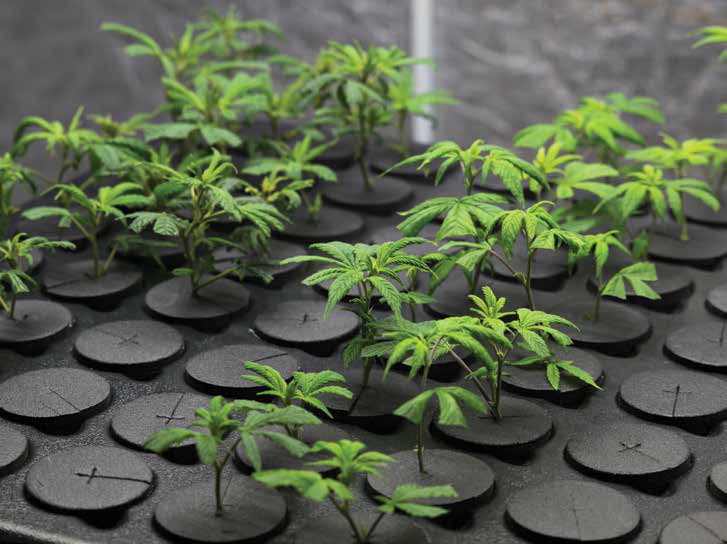
I. Introduction
Everywhere we look, from the aisles at the grocery store touting CBD (Cannabidiol) oils and cookies, to the newest startup, cannabis products abound. With the cannabis market valued in the billions of dollars worldwide, it is likely that a variety of businesses, from manufacturing to banking, will soon touch on cannabis in some way, making it critical for businesses to understand the cannabis landscape. Unfortunately, the ever-growing volume of information (and misinformation) make it challenging for businesses to stay abreast of the state of the law and the current trends. This article provides a crash course in cannabis to arm in-house counsel with basic information about this burgeoning industry.
II. What’s in a name? Understanding cannabis terminology
In the increasingly complex world of cannabis, terminology is important. Here are some definitions that go to the heart of discussions around cannabis.
Cannabis sativa L. (cannabis): The plant from which marijuana and hemp are derived. The term cannabis itself has no formal legal definition.
Marijuana: The Controlled Substances Act (CSA) defines marijuana as “all parts of the plant Cannabis sativa L., whether growing or not; the seeds thereof; the resin extracted from any part of such plant; and every compound, manufacture, salt, derivative, mixture, or preparation of such plant, its seeds, or resin.” As of December 20, 2018, the definition of marijuana excludes hemp, which is defined as cannabis with 0.3 percent or less of THC (the psychoactive component in cannabis, defined fully below).
The CSA provides 5 exceptions to the definition of marijuana: (i) mature stalks of such plants; (ii) fiber produced from such stalks; (iii) oil or cake made from the seeds of such plant; (iv) any other compound, manufacture, salt, derivative, mixture, or preparation of such mature stalks, fiber, oil or cake; and (v) the sterilized seed of such plant which is incapable of germination. However, resin of a cannabis plant (even if the resin is extracted from one of the 5 exemptions above), is considered marijuana under the CSA, notwithstanding the other exemptions. 21 U.S.C. § 802.
Cannabinoid: The term for chemical compounds found in the cannabis plant. There are over 100 different cannabinoids, of which THC and CBD (explained on the next page) are two.
Tetrahydrocannabinol (THC): One of many cannabinoids found in the cannabis plant and the principal psychoactive element of cannabis (the element that causes the high and other psychoactive effects).
Cannabidiol (CBD): Another type of cannabinoid. CBD is a compound that can be derived from hemp or marijuana. Studies about its effects are mixed. Some studies show that its use may reduce incidence of seizures in some people. The United States Food and Drug Administration (FDA) has approved Epidiolex, the first CBD-based drug to treat seizures.
Hemp: A variety of cannabis plant with 0.3 percent or less of THC. Until the passage of the Agricultural Improvement Act of 2018 (colloquially known as the 2018 Farm Bill), hemp was a controlled substance under the CSA. The 2018 Farm Bill excludes hemp from the CSA’s definition of marijuana. Growing and selling hemp are now legal, though such activities will be highly regulated.
III. How did we get here? Key developments in cannabis law and policy
In short, while it has been legalized to varying degrees in more than 30 states, marijuana use of any kind remains illegal under federal law. Moreover, businesses or individuals providing ancillary support to a marijuana business could be exposed to criminal liability for aiding and abetting a violation of federal law. That said, to fully understand the state of affairs today, it is helpful to review the key developments relating to cannabis law and policy over the past half-century in the US. This timeline provides the highlights:
Early history – 1970s-2012. The CSA was enacted in 1970, prohibiting use of marijuana under federal law. Beginning in 1973, individual states began to pursue decriminalization and otherwise relax their state regulatory schemes surrounding marijuana. From the mid-1990s on, various states passed medical marijuana legislation, with recreational legalization beginning on the state level in 2012.
Federal guidance – 2012-2016. As more states began decriminalizing marijuana use or otherwise relaxing their regulatory schemes, the Obama Administration issued guidance to address some of the ensuing confusion between federal law, which still prohibited marijuana use, and state law. Specifically, the administration issued a series of memoranda (known as the Cole Memos and named for their author, Deputy Attorney General James Cole), which set forth the federal government’s stance against enforcing federal marijuana laws in states that have legalized the drug in some way. At the same time, the Financial Crimes Enforcement Network (FinCEN) issued guidance clarifying Bank Secrecy Act expectations for financial institutions seeking to provide services to marijuana-related businesses.
Present day. The Trump Administration has sent mixed messages concerning marijuana legalization. In January 2018, then-Attorney General Jeff Sessions rescinded the Cole Memos, emphasizing prosecutorial discretion and the dangers of marijuana as a drug. Notably, the FinCEN guidance was not rescinded and remains in place. Since then, various Trump Administration officials have made statements about the administration’s stance on marijuana indicating both support for and against states’ rights to implement and enforce their own marijuana policies.
As of this writing, 33 states and the District of Columbia have legalized marijuana for medical use and 10 states and the District of Columbia have legalized it for recreational use. However, the use and possession of marijuana remains illegal under federal law, and businesses providing support to marijuana businesses could be found liable for aiding and abetting a violation of federal law.
IV. Hot topics: Key issues in cannabis
In view of this tension between federal and state law and the fluid but robust regulatory environment, there are certain key issues that dominate industry dialogue from a legal perspective. While not exhaustive, this list provides a meaningful overview of the pressure points in certain key areas.
Congressional reform. A myriad of marijuana reform bills have been introduced in Congress touching on a variety of aspects of the industry. The majority share a common theme: addressing the tension between federal and state laws. For example, the following bills, among others, were recently introduced in Congress: (1) the Sensible Enforcement of Cannabis Act of 2019, which proposes to direct the Attorney General to focus on certain enforcement priorities; (2) the SAFE Banking Act (recently reintroduced after failing during a previous Congressional session), which seeks to protect banks and insurers from prosecution under the CSA for providing services to marijuana businesses operating legally under state law; and (3) the Ending Federal Marijuana Prohibition Act of 2019, introduced with bipartisan support, which proposes to remove marijuana from the list of controlled substances, allowing states to regulate marijuana as they choose.
That said, to fully understand the state of affairs today, it is helpful to review the key developments relating to cannabis law and policy over the past half-century in the US.
Banking and financial services. The tensions between federal and state law pose challenges for marijuana businesses, who often operate as cash businesses as the majority of banks, unwilling to risk criminal exposure, choose not to serve marijuana-related businesses. As of December 2018, FinCEN reported that approximately 438 banks and 113 credit unions are providing banking services to marijuana-related business. The passage of the SAFE Banking Act, discussed on the previous page, could alter the banking landscape significantly.
CBD and food. On the same day that the 2018 Farm Bill was passed, legalizing hemp at the federal level, the FDA released a strongly worded statement warning producers that they cannot use health claims to sell CBD, which is most often derived from hemp and touted as a cure-all for a variety of ailments. Since then, the lack of specific regulation around CBD has frustrated businesses and caused confusion at the state level. In recent months, New York City, Ohio, and Maine have prohibited restaurants from selling CBD-infused food and drink, asserting that the FDA does not recognize those products as safe. In response to frustration and confusion from businesses and consumers, the FDA is holding its first public hearing on the issue in May 2019. The hearing is likely to be a first step in the process of developing a meaningful framework for CBD-infused products that are within the FDA’s purview.
Hemp regulations. While hemp is now legal under federal law, it cannot be grown as freely as one might grow vegetables in the garden. Rather, the 2018 Farm Bill requires state departments of agriculture to consult with the state’s governor and chief law enforcement officer to devise a regulatory plan that must be submitted to the Secretary of the US Department of Agriculture (USDA). It will become important for businesses to monitor the submission of these plans and to determine how the states and USDA will work together to implement and harmonize them in the context of interstate commerce.
Data privacy. In their highly regulated environment, cannabis businesses collect a significant amount of personal data from birth dates to medical histories, often reporting to governmental entities directly through the use of electronic databases. As such, there has been increasing attention paid to how these businesses can meaningfully implement data security and privacy systems that are both compliant and robust to ensure protection of customer information. Given the lingering social stigma associated with cannabis use, this drive for privacy is strong from the customer side as well.
Blockchain technology. The drive for transparency and the lack of availability of traditional payment methods means some cannabis startups are opting to power their transactions using blockchain technology. The use of blockchain technology promises transparency and ease to both buyer and seller. It has the potential to solve a multitude of the problems currently plaguing the industry, from cash dependency and limited tracking to taxation limitations and tainted or fake product. Layering a disruptive technology atop an exponentially growing market with a fluid legal landscape will pose novel and intriguing questions to businesses and will require creative and innovative implementation and ongoing monitoring.
The drive for transparency and the lack of availability of traditional payment methods means some cannabis startups are opting to power their transactions using blockchain technology
Canada. Our neighbor to the north legalized cannabis for recreational purposes in October 2018, and this legalization could impact US businesses in significant ways. A Canadian cannabis company that sells, imports, or distributes marijuana in or into the US violates the CSA. US companies that do business with or provide ancillary services to Canadian cannabis companies who sell or distribute marijuana into the US thus can be liable for aiding and abetting the Canadian company’s violation of the CSA, and US businesses that are collaborating or partnering with Canadian companies need to ensure sufficient diligence where cannabis is concerned.
Global status and trends. While only Canada and Uruguay have fully legalized the use of recreational cannabis, dozens of countries have legalized cannabis for medicinal purposes, otherwise decriminalized its use, or adopted a relaxed stance toward enforcement. On a global level, the economic promise of the cannabis market seems to be driving a trend toward legalization. In addition, from the vantage point of growth and investment, there seems to be a particular focus on Asia. According to New Frontier Data, China’s 2017 hemp sales totaled over $1 billion, about a third of the global hemp market (though Chinese hemp is used mostly in textiles). According to a July 2018 article in Forbes Magazine, Chinese companies also held over 600 patents for cannabis-related uses. While marijuana use remains illegal in China, it has not stopped Chinese investors from participating in the burgeoning global marketplace.
V. Where do we go from here? What to expect in 2019 and beyond
As we approach the midpoint of 2019, many important legal questions are likely to advance the dialogue on cannabis in the US. Notably, the FDA’s April hearing, the status of the current marijuana reform bills, and implementation of hemp regulation could impact the manner in which companies do business and how and where CBD products are sold.
Regardless of the outcome on the legal front, however, one thing is clear: the cannabis industry is poised to experience exponential growth worldwide and businesses would be wise to understand the nuanced landscape in which the industry is currently operating.





